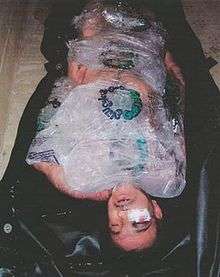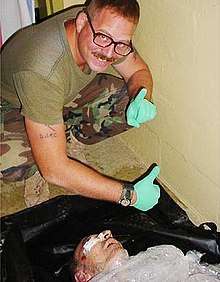Death of Manadel al-Jamadi
Manadel al-Jamadi (Arabic: مناضل الجمادي) was a suspected terrorist who was tortured to death in United States custody during Central Intelligence Agency interrogation at Abu Ghraib Prison on 4 November 2003.[1] His name became known in 2004 when the Abu Ghraib scandal made news; his corpse packed in ice was the background for widely reprinted photographs of grinning U.S. Army specialists Sabrina Harman and Charles Graner each offering a "thumbs-up" gesture. Al-Jamadi had been a suspect in a bomb attack that killed 12 people in a Baghdad Red Cross facility.[2]
Manadel al-Jamadi | |
|---|---|
 | |
| Born | |
| Died | 4 November 2003 |
| Cause of death | Blunt trauma |
| Nationality | Iraqi |
| Conviction(s) | Terrorism (presumed) |
A military autopsy declared al-Jamadi's death a homicide. No one has been charged with his death. In 2011, Attorney General Eric Holder said that he had opened a full criminal investigation into al-Jamadi's death.[3] In August 2012, Holder announced that no criminal charges would be brought.[4]
Circumstances of death


US Navy SEALs had apprehended al-Jamadi following the 27 October 2003 bombing of Red Cross offices in Baghdad that killed 40 people and left more than 200 wounded amongst US troops. At approximately 4 a.m. on 4 November 2003, al-Jamadi was led by American forces into the prison, naked from the waist down wearing only a purple shirt and jacket with a green sandbag over his head, while answering questions in both Arabic and English with his handlers.[1][5]
A ghost prisoner (a detainee not logged in the records) said he was passive and nervous "like a scared child," and there was reportedly "no need to get physical with him," although an interrogator soon started shouting at him, demanding to know where weapons were hidden.[5]
The cause of his death was not generally known until 17 February 2005, when it was revealed that he had died after a fruitless half-hour interrogation, during which, contrary to official guidelines, he was suspended from a barred window by his wrists, which were bound behind his back. News reports called al-Jamadi's treatment Palestinian hanging torture.[6] Associated Press correspondent Seth Hettena reported that 30 minutes after beginning his questioning of the prisoner, the CIA interrogator called for guards to reposition al-Jamadi, who he believed was "playing possum" as he slouched with his arms stretched behind him. But the guards found otherwise:
"After we found out he was dead, they were nervous," Specialist Dennis Stevanus said of the CIA interrogator and translator. "They didn't know what the hell to do."[1]
According to Spc. Jason Kenner, an MP with the 372nd Military Police Company, al-Jamadi was brought to the prison by Navy SEALs in good health; Kenner says he saw that al-Jamadi looked extensively bruised when he was brought out of the showers, dead. According to Kenner a "battle" took place among CIA and US military interrogators over who should dispose of the body.[7]
Captain Donald Reese, company commander of the 372nd Military Police Company, gave testimony about al-Jamadi's death, saying of the dead prisoner, "I was told that, when he was brought in, he was combative, that they took him up to the room and during the interrogation he passed[...]. [The body] was bleeding from the head, nose, mouth."[8] Reese stated that the corpse was locked in a shower room overnight and the next day was fitted with an intravenous drip; he said that this was an attempt to hide what occurred from other inmates. Reese said the body was then autopsied, establishing the cause of death as a blood clot from trauma.
Staff Sergeant Ivan Frederick wrote an account to his family in November 2003 that interrogators had
stressed him out so bad that the man died. [Prison personnel] put his body in a body bag and packed him in ice for approximately twenty-four hours in the shower. [...] The next day the medics came and put his body on a stretcher, placed a fake IV in his arm and took him away.[9]
Al-Jamadi came to be known by some Abu Ghraib personnel as "The Iceman" and "Mr. Frosty." Others called him "Bernie," a reference to the movie Weekend at Bernie's in which a dead body is treated as if still alive.[10]
Investigation and charges
In August 2007, Thomas Pappas, the most senior officer present during the interrogation and time of death, was granted immunity in return for his testimony at the court martial of his subordinate Lieutenant Colonel Steven L. Jordan, who was acquitted.[11] In 2011, John Durham, Republican-appointed U.S. Attorney from Connecticut tasked with probing the CIA — has begun calling witnesses before a secret federal grand jury in Alexandria, Virginia, looking into, among other things, the death of al-Jamadi.[12]
In other media
Anthony Diaz, Jeffery Frost, Sabrina Harman, and Javal Davis are interviewed in the 2008 film Standard Operating Procedure about al-Jamadi's presence and corpse at Abu Ghraib.[13]
References
- Hettena, Seth (17 February 2005). "Reports detail Abu Ghraib prison death; was it torture?". Associated Press. Retrieved 23 June 2009.
- Perry, Tony (28 May 2005). "SEAL Officer Not Guilty of Assaulting Iraqi". Los Angeles Times. Archived from the original on 5 March 2009. Retrieved 28 January 2009.
- "The Death of an Iraqi Prisoner". NPR. Archived from the original on 19 January 2013. Retrieved 25 January 2013.
- Shane, Scott (30 August 2012). "No Charges Filed on Harsh Tactics Used by the C.I.A." The New York Times. Retrieved 25 January 2013.
- Mayer, Jane, "The Dark Side: The Inside Story of How the War on Terror Turned Into a War on American Ideals", 2008. p. 239-252
- "'Palestinian hanging' torture revealed - After Saddam". SMH. 18 February 2005. Archived from the original on 29 May 2014. Retrieved 25 January 2013.
- "More Iraq Prisoner Abuse Photos Surface". ABC News. 19 May 2004. Archived from the original on 2 February 2011. Retrieved 25 January 2013.
- Filkins, Dexter (25 June 2004). "The reach of war: Abuse; Testimony Ties Key Officer to Concealing of Iraqi Death". The New York Times. Archived from the original on 3 April 2015. Retrieved 8 June 2009.
- Hersh, Seymour M. (10 May 2004). "Torture at Abu Ghraib". The New Yorker. Archived from the original on 2 March 2009. Retrieved 8 June 2009.
- Zagorin, Adam (14 November 2005). "Haunted by "The Iceman"". Time. Archived from the original on 8 May 2009. Retrieved 8 June 2009.
- "Charges Sought Against Officer at Abu Ghraib". Los Angeles Times. 13 January 2006. Archived from the original on 5 April 2013. Retrieved 25 January 2013.
- Thompson, Mark (13 June 2011). "Haunted by Homicide". Time. Archived from the original on 13 January 2013. Retrieved 25 January 2013.
- Standard Operating Procedure (2008 film). 53 to 63 minutes in.
External links
| Wikimedia Commons has media related to Manadel al-Jamadi. |
- Perry, Tony (28 May 2005). "SEAL Officer Not Guilty of Assaulting Iraqi". Los Angeles Times.
- "A Deadly Interrogation -- Can the C.I.A. legally kill a prisoner?". The New Yorker. 14 November 2005.
- "Other government agencies". Salon.com. 14 March 2006. Archived from the original on 12 February 2008.
- Morris, Errol (19 May 2008). "The Most Curious Thing". New York Times. Archived from the original on 20 May 2008. Retrieved 20 May 2008.